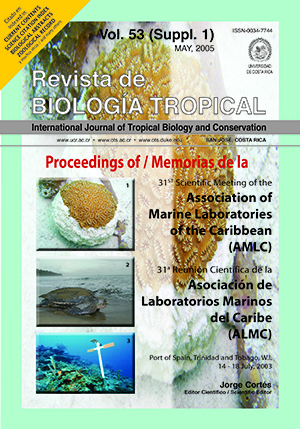Abstract
This study examines scleractinian zooxanthellate coral recruitment patterns in the Florida Keys to determine if differences in density or community composition exist between regions. From July to September 2002, nine patch reefs, three in each of the upper, middle and lower Keys, were surveyed for coral recruits (colonies <5 cm in diameter) using randomly placed quadrats and transects. Coral recruits were enumerated, measured, and identified to genus. Fourteen genera of corals were observed across all sites and ranged from five to 13 per site. Densities ranged from 6.29 ± 1.92 (mean ± SE) to 39.08 ± 4.53 recruits m-2, and there were significant site and regional differences in recruit densities. The density of recruits in the upper Keys was significantly lower than in the middle and lower Keys. In addition, the upper Keys were less diverse and had a different recruit size-frequency distribution. The majority of recruits were non-massive scleractinian species that contribute relatively little to overall reef-building processes, a finding that is similar to previous studies. Fewer recruits of massive species were found in the upper Keys compared to the middle and lower Keys. The recruitment patterns of the reefs in the upper Keys could potentially hinder their ability to recover from stress and disturbances.References
Bak, R.P.M. & M.S. Engel. 1979. Distribution, abundance and survival of juvenile hermatypic corals (Scleractinia) and the importance of early life history strategies in the parent coral community. Mar. Biol. 54: 341-352.
Chiappone, M. & K.M. Sullivan. 1996. Distribution, abundance and species composition of juvenile scleractinian corals in the Florida reef tract. Bull. Mar. Sci. 58: 555-569.
Dunstan, P.K. & C.R. Johnson. 1998. Spatio-temporal variation in coral recruitment at different scales on Heron Reef, southern Great Barrier Reef. Coral Reefs 17: 71-81.
Dustan, P. 1977. Vitality of reef coral populations off Key Largo, Florida: Recruitment and mortality. Environ. Geol. 2: 51-58.
Dustan, P. & J.C. Halas. 1987. Changes in the reef-coral community of Carysfort Reef, Key Largo, Florida: 1974-1982. Coral Reefs 6: 91-106.
Edmunds, P.J. 2000. Patterns in the distribution of juvenile corals and coral reef community structure in St. John, US Virgin Islands. Mar. Ecol. Prog. Ser. 202: 113-124.
Edmunds, P.J., R.B. Aronson, D.W. Swanson, D.R. Levitan & W.F. Precht. 1998. Photographic versus visual census techniques for the quantification of juvenile corals. Bull. Mar. Sci. 62: 937-946.
Ginsburg, R.N. & E.A. Shinn. 1994. Preferential distribution of reefs in the Florida reef tract: The past is the key to the present, p. 21-26. In R.N. Ginsburg, Compiler. Proceedings of the colloquium on global aspects of coral reefs: Health, hazards and history, 1993. Rosenstiel School of Marine and Atmospheric Science, University of Miami, Miami.
Ginsburg, R.N., E. Gischler & W.E. Kiene. 2001. Partial mortality of massive reef-building corals: an index of patch reef condition, Florida reef tract. Bull. Mar. Sci. 69: 1149-1173.
Hughes, T.P. & J.E. Tanner. 2000. Recruitment failure, life histories, and long-term decline of Caribbean corals. Ecology 81: 2250-2263.
Lapointe, B.E. 1997. Nutrient thresholds for bottom-up control of macroalgal blooms on coral reefs in Jamaica and southeast Florida. Limnol. and Oceanogr. 42: 1119-1131.
Lapointe, B.E. & M.E. Clark. 1992. Nutrient inputs from the watershed and coastal eutrophication in the Florida Keys. Estuaries 15: 465-476.
Lessios, H.A. 1988. Mass mortality of Diadema antillarum in the Caribbean: What have we learned? Ann. Rev. Ecol. Syst. 19: 371-393.
Porter, J.W. & O.W. Meier. 1992. Quantification of loss and change in Floridian reef coral populations. Am. Zool. 32: 625-640.
Porter, J.W., V. Kosmynin, K.L. Patterson, K.G. Porter, W.C. Jaap, J.L. Wheaton, K. Hackett, M. Lybolt, C.P. Tsokos, G. Yanev, D.M. Marcinek, J. Dotten, D. Eaken, M. Patterson, O.W. Meier, M. Brill & P. Dustan. 2002. Detection of coral reef change by the Florida Keys coral reef monitoring project, p. 749-769. In J.W. Porter & K.G. Porter (eds.). The Everglades, Florida Bay, and coral reefs of the Florida Keys: An ecosystem sourcebook. CRC, Boca Raton, Florida.
Shinn, E.A., B.H. Lidz, J.L. Kindinger, J.H. Hudson & R.B. Halley. 1989. Reefs of Florida and Dry Tortugas: Field trip guidebook T176, 28th Int. Geol. Congr. Amer. Geophys. Union, Washington, DC. 53 p.
Smith, S.R. 1997. Patterns of coral settlement, recruitment and juvenile mortality with depth at Conch Reef, Florida. Proc. 8th Int. Coral Reef Symp. 2: 1197-1202.
Smith, S.V. & R.W. Buddemeier. 1992. Global change and coral reef ecosystems. Ann. Rev. Ecol. Syst. 23: 89-118.
Szmant, A.M. 1986. Reproductive ecology of Caribbean reef corals. Coral Reefs 5: 43-54.
Underwood, A.J. & M.J. Keough. 2001. Supply-side ecology: The nature and consequences of variations in recruitment of intertidal organisms, p.183-200. In M.D. Bertness, S.D. Gaines & M.E. Hay (eds.). Marine Community Ecology. Sinauer, Massachusetts.
Van Moorsel, G.W.N.M. 1988. Early maximum growth of stony corals (Scleractinia) after settlement on artificial substrata on a Caribbean reef. Mar. Ecol. Prog. Ser. 50: 127-135.
Comments

This work is licensed under a Creative Commons Attribution 4.0 International License.
Copyright (c) 2005 Revista de Biología Tropical






